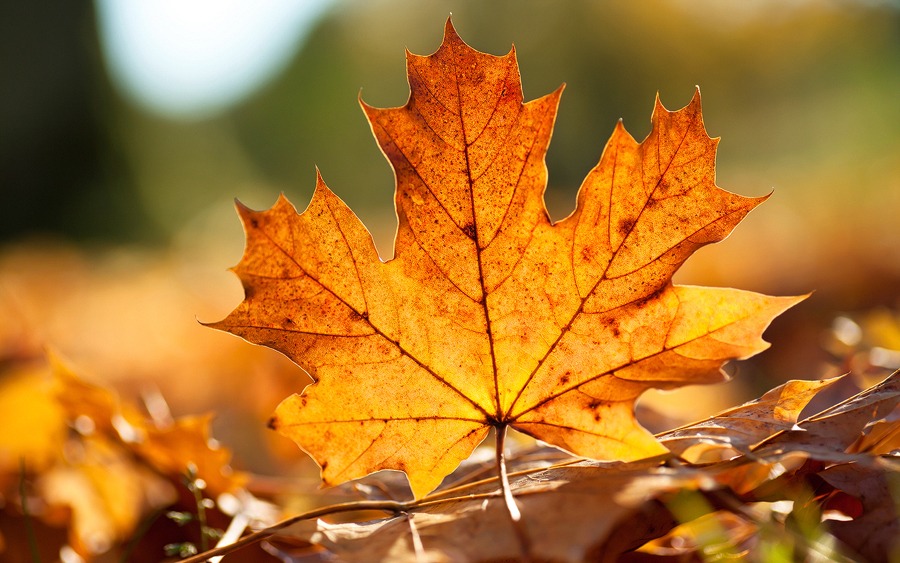There’s a reason we all love the striking colors of fall foliage. The mosaic of reds, gold, and yellows is one of nature’s most remarkable displays, but even the most beautiful leaves will eventually fall. When too many accumulate in your yard, they can smother the lawn and keep it from growing. They can also attract pests. To avoid these problems, you may end up having to spend hours raking and bagging fallen leaves. While you can’t altogether avoid this chore, these leaf-raking tips from the tree pros at Red’s Tree Service can make the process faster and more efficient so you can enjoy those perfect Mid-South fall days.
Use the Right Rake
There are a couple of things to consider when picking out a rake. You want a rake that is both comfortable to use and effective. Narrow rakes don’t gather as many leaves at a time, and the chore will take you much longer than necessary. Also, look for rakes labeled “no-clog.” These have angled tines that won’t pierce the leaves and create blockages.
If you can’t keep a good posture while you’re raking, you’ll become tired and sore. You could even injure your back. Plus, you’ll have to rake more often since you can’t do it as long. To avoid this, choose the right rake for your body. Before you buy your rake, make sure it feels good to use.
Wait for Leaves to Falling
Don’t bother raking every time a new batch of leaves falls. Wait until your trees are practically bare before taking on the job.
Save Time With Tarps
If the thought of filling small bags from a large pile of leaves over and over again sounds agonizing, consider raking your leaves on to a lightweight tarp. You can then tie the ends of the tarp together to take the leaves to a community collection center. Or, you can roll the tarp into a cylinder and funnel the leaves into your bags much more efficiently.
Rake Before it Rains
If rain is in the forecast, don’t put off raking that carpet of leaves you’ve meant to get around do. After a rainstorm, fallen leaves become soggy and dense, clumping together and clogging rakes, vacuums, and leaf blowers. All of this will make the task much more of a headache.
Make Sure You’re Comfortable
Comfort may not be the first thing on your mind when it comes to household chores, but it’s not something you should overlook for labor-intensive projects. Fallen leaves are dry and dusty, and the particles that raking, mowing, and leaf blowing stir up can irritate your eyes, sinuses, and irritate exposed skin. The dust is especially significant if you have allergies or asthma. Wearing a dust mask will keep you comfortable and safe, and a long-sleeved shirt and long pants can protect your skin.
It’s also smart to wear durable work gloves, especially if you don’t do this repetitive motion often. Raking can cause painful blisters on unprotected hands. Remember to stand up straight and switch your leading hand to prevent fatigue and injury.
And, of course, know your personal limits. There’s no need to rush through the job and wear yourself out. You’ll have several weeks to rake, so stop when you feel tired.

Mulch While You Mow
If you only have a few fallen leaves in your yard, you can get rid of them while mulching your lawn at the same time. Just mow over the leaves. If your lawnmower has a mulch setting, even better. The blades will chop the dry leaves into small flakes that will quickly decompose and add nutrients to your lawn.
Rake Small Piles to Bag
If a kid or kid at heart has been looking forward to playing in a big pile of leaves, it’s best to bag or remove the leaves right away. Otherwise, a gust of wind can undo all your hard work. If you’re planning on bagging the leaves, rake into piles about the size of the bag. This will also make it easier to take breaks when you’re tired because you aren’t leaving anything undone.
Use Leaf Blowers and Vacuums
Leaf blowers and vacuums can do a lot of your work for you. As the name suggests, a leaf blower can significantly reduce the time you spend raking if you use it correctly. Start by sectioning out the yard and establishing a grid pattern, then work the leaf blower back and forth in rows. Make sure you aren’t too close or too far from the leaves. It can take a little time to get your technique just right, but it can be worth it in the long run.
You may also consider investing in a yard vacuum with a built-in shredder. The vacuum sucks up the leaves and then chops them up into small pieces, so you don’t need to use as many bags. Yard vacuums also make it easier to pick up leaves under shrubs, between bushes, on top of stone or mulch, and in other places where raking can be tricky.
Some leaf blowers include a vacuum or mulch setting, so you get the best of both tools. You can use the chewed-up leaves from using the mulch setting to make leaf mold, an all-natural, nutrient-rich mulch-type dressing to replace store-bought mulch.
Plan Your Grid
If you put all of your leaves in a central location, you’ll waste a lot of time and energy running back and forth. Instead, plan a raking grid by separating your lawn into sections and raking each section row by row. Using a grid pattern makes it easier to have a perfectly clean lawn.
Let The Wind Work for You
Breezy fall weather may seem like a hindrance to your leaf raking, but you can actually use it to your advantage. Rake in the same direction the wind is blowing, and the gusts will help move the dry leaves along. If you rake against the wind, you’ll have to work twice as hard as the leaves blow back the way you came.
If you found these leaf-raking tips helpful, contact Red’s Tree Service for more tree care tips or services that require the experience of a professional.
